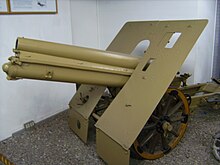kuk artillery shooting school
The Austro-Hungarian Artillery Shooting School was originally a single educational institution of the Austro-Hungarian Army . By 1912 it was significantly increased and subdivided, so that it finally consisted of three separate components (two of them at the Hajmáskér location ), each of which was also called an artillery shooting school .
In 1914 the field cannon regiment No. 11 and the heavy Howitzer Division No. 4 formed the main units.
prehistory
Beginnings
Although it was recognized that not only the quantity but also the quality played a not insignificant role, the kuk artillery had no facilities for training budding artillerymen until 1874 . Between 1874 and 1896 there were only annual high-speed shooting courses lasting four to six weeks. Here the frequentants (participants) of the higher artillery course and the captains of the staff officer course (field and fortress artillery officers) gathered at the Steinfelde military training area. The faculty consisted of the training officers of the higher artillery course. The task of this provisional shooting school was only to put into practice the detailed knowledge of shooting theory acquired in the preliminary courses. The tactical use of artillery was not taken into account. Mainly, care was taken to literally implement the existing regulations and not to deviate from the existing regulations during the target practice. The monotonous shooting against primitive targets on a flat surface (as it was given on the stone field) did not help to increase the motivation of the participants in these courses.
Improvements from 1896 to 1910
The separation of artillery in 1896 as part of a reform into the concrete status groups field or mountain artillery on the one hand and fortress artillery on the other also resulted in a change in the shooting training of officers. School shooting departments for field artillery and fortress artillery were established, whose task it would be in the future to provide intensive special training in both technical and tactical shooting. Each school department was assigned a permanent teaching body, which was given the opportunity to keep itself up to date by studying the relevant specialist literature on the artillery of foreign armies, the exercise reports of their own artillery, etc.
Furthermore, the duration of the courses was doubled to three months, the number of course participants increased and in 1896 three separate combat firing ranges ( Tata (Totis) , Nagyszeben (Hermannstadt) and Lippa ) were set up for the field artillery, on which the training in war leadership and tactical use of the batteries could be practiced effectively. The fortress artillery , however, had to be content with the existing provisional structure until the Hajmáskér lock was built in 1901.
Locations of the artillery shooting school
Hajmáskér
In 1901 the Austro- Hungarian War Ministry acquired a 6,000- hectare site near the small town of Hajmáskér ( Wesprim County , Hungary) in order to establish a central shooting school there. For this purpose, a 26-hectare barracks was built south of the shooting range (this was used by Soviet troops until they withdrew from Hungary), which was designed for 250 officers, 2,200 men and 1,120 horses. Hajmáskér was thus the largest artillery garrison in the Austro-Hungarian monarchy.
Both field and fortress artillery could be trained here . Škoda also tested new guns in Hajmáskér .
Kalinovik
Due to the nature of the area in Hajmáskér, however, the possibilities of the mountain artillery were still limited. This component was therefore initially only temporarily relocated to Kalinovik in Bosnia and Herzegovina . Here, too, the teaching staff was initially only seconded and returned to their units after the courses were over.
The completely inadequate conditions on site were gradually improved, from 1910 a permanent head of the school was appointed and the training staff was assigned to this institution on a permanent basis. The course participants were divided into groups and the initially modest battery exercises were extended to divisional ( battalion ) and regimental levels. Budget funds made available made it possible to improve and complete the required target material. The increasingly higher valuation of mountain artillery also leads to information courses for staff officers , creating a broader basis for the training of this type of weapon.
Reform of the artillery teaching system in 1910
In 1910 there was a reorganization in the field of artillery teaching. The previous shooting school department in Hajmáskér for field artillery was converted to the field artillery shooting school, the previous shooting school department in Hajmáskér for fortress artillery to the fortress artillery shooting school. The provisional facility in Kalinovik was upgraded to a mountain artillery shooting school. All three schools were now subordinate to the general artillery inspector.
The uniform management of the three schools made it possible to maintain the high standard achieved so far. With the detailed draft of the "Organic Regulations for the Austro-Hungarian Artillery Shooting Schools" issued by the Austro-Hungarian War Ministry, provision was made that not only battery commanders and active younger officers, but also older officers in the reserve, were trained and / or trained in all branches of the artillery command in the three shooting schools the existing knowledge has been refreshed.
Higher troop commanders and staff officers were given the opportunity to learn about the mode of operation and the nature of modern artillery by conducting large-scale exercises.
literature
- Colonel of the artillery staff Wilhelm Elmar: The kuk artillery shooting school . Article in Moderne Illustrierte Zeitung , double issue 10/11, Vienna June 1, 1914, Siegmund Bergmann (Ed.)
- M. Christian Ortner , The Austro-Hungarian Artillery from 1867 to 1918 , Verlag Militaria, Vienna 2007, ISBN 978-3-902526-12-0






